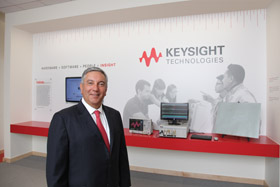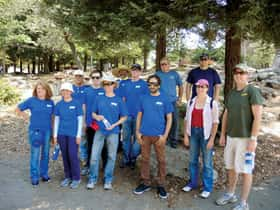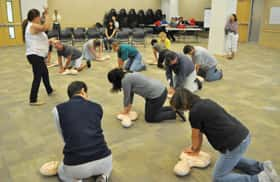It’s a new beginning for Keysight Technologies.
 In early November, Agilent Technologies is scheduled to complete the spin-off of its electronic measurement division into a stand-alone company, Keysight Technologies. The newly independent Keysight, headquartered on a sprawling campus on Santa Rosa’s Fountaingrove Parkway, treads a familiar path: In 1999, then 60-year-old technology leader Hewlett-Packard (HP) spun off several departments, including its founding electronic measurement business, so it could focus on the growing computer/PC industry. That spin-off was dubbed Agilent.
In early November, Agilent Technologies is scheduled to complete the spin-off of its electronic measurement division into a stand-alone company, Keysight Technologies. The newly independent Keysight, headquartered on a sprawling campus on Santa Rosa’s Fountaingrove Parkway, treads a familiar path: In 1999, then 60-year-old technology leader Hewlett-Packard (HP) spun off several departments, including its founding electronic measurement business, so it could focus on the growing computer/PC industry. That spin-off was dubbed Agilent.“Over the years, HP had expanded into other areas of business, and they were moving in a different direction than the divisions that were to become Agilent Technologies,” says Jeff Weber, former Sonoma County public affairs manager for Agilent, who now is a member of Keysight’s communications and public affairs team. “It’s a similar rationale this time. The goal is for each division to be able to focus on its expertise.
“The businesses that will remain with Agilent, headquartered in Santa Clara, will include life sciences, diagnostics and applied markets [LDA],” he continues. “Those businesses were moving in a different direction than the company’s electronic measurement business.”
“As the company continued to grow, we realized there were two major parts of the business: the electronic measurement business and the LDA portion of the company. Both of them had different markets, customers, sales staffs, facilities and, increasingly, very different investors,” explains Ron Nersesian, former executive vice president of Agilent and now president/CEO of Keysight. “Investors had been asking for the split for a long period of time. They wanted to be able to offer only the health portion or only the electronics portion to their clients.”
In September 2013, the Agilent board of directors voted to spin-off the electronic measurement business (EM). In August 2014, EM started doing business as Keysight Technologies, a wholly owned subsidiary of Agilent. This month, the split will be finalized, when Keysight gives a dividend to all Agilent shareholders and begins trading independently on the New York Stock Exchange (NYSE: KEYS).
Inside Keysight
Although it’s been operating in Sonoma County since 1972 (and at the Fountaingrove location since 1975), many locals may be unclear about what Keysight does—and for whom. “We’re the world’s leading electronic measurement company,” says Weber. “We create a variety of solutions, including hardware, software and systems, and we also provide services. Keysight holds the number one position in our industry segments of communications, aerospace and defense, and industrial, computers and semiconductors.”
Keysight doesn’t make consumer products. Instead, “Our products are used by some of the world’s major technical industries,” he continues. “Those technical employees use our products and equipment on a daily basis, in most cases, to advance the work they’re doing.”
A visit to the Agilent/Keysight website brings some clarity to Weber’s words. In its Electronic Measurement Newsroom, multiple articles and white papers detail products that are used to develop, test and maintain smartphones, cell towers and communications infrastructure; radar systems, from traffic enforcement and weather prediction to military applications, including satellites; and semiconductors and integrated circuits that can be found in consumer goods as wide ranging as cars, household appliances, alarm systems and video game consoles.
On a tour of the campus, Weber shows me samples of Keysight’s product offerings—including various tiny circuit boards and boxy testing consoles—along with brief explanations of how they’re used. Most of it is too technical for my liberal arts major’s brain, but what I can understand is that Keysight is keeping its development process local.
“We have technical capabilities that can’t be purchased elsewhere,” says Weber. “That gives our products a competitive advantage. A significant amount of our initial manufacturing is done here in Santa Rosa to ensure quality and performance—we still have a major manufacturing presence here in Sonoma County, with approximately 400 employees [once a technology or product is perfected, most of the volume manufacturing is done in Penang, Malaysia]. That makes us one of the largest manufacturers in the North Bay. I think there may be a misconception that we no longer do any manufacturing here, but that’s simply not the case.”
In addition to keeping its initial, new product introduction (NPI) work here, last year, the company built a new facility on campus that lets it do more environmental tests on its products. “Before, we’d have to farm that work out,” says Weber. “Now we can do it onsite.”
 Opportunities ahead
Opportunities ahead
“Our employees were very excited,” says Nersesian when asked about internal reaction to news of the company split. “For almost 30 years, the electronic measurement business—what’s now Keysight—has been producing profits that have helped fund the HP computer group, the HP printer group and, most recently, the Agilent health care group. So they’re now very excited to be an independent company that will use some of the value it creates to fund its own growth.
“Most of the acquisitions we’ve done in recent years have been in health care,” he continues. “Now we’ll be looking at those kinds of opportunities that make sense in the electronic measurement realm that also provide good returns.”
Nersesian points to three main megatrends driving Keysight’s business forward: mobile data traffic and wireless communication, modernization of aerospace and defense, and increased electronic content. “In the wireless space, there continues to be an almost insatiable demand for more and more data traffic over mobile devices. We’re right at the heart of this mobile revolution with our wireless business, and we’re looking to continue to expand and make sure we have a complete portfolio of products—hardware, software and server.
“The second area is the modernization of the general aerospace and defense offerings that currently exist. As we try to defend our country, we need newer and newer tools that help keep us safer.
“And the third sector is our electronic content that’s going into all types of products with computers in them or as part of them, including testing semiconductors or industrial products that are including more and more electronic content.”
Corporate citizenship
With close to 1,200 local employees, Keysight will continue to be a major factor in the North Bay’s economic success.
“As Keysight moves forward at the forefront of the technologies it’s developing, it brings the right kind of attention to Sonoma County,” says Ben Stone, executive director of the Sonoma County Economic Development Board. “The company has been such a tremendous asset in its nearly 40 years in Sonoma County, not only bringing in revenue and profits, but talent as well. The Hewlett Packard/Agilent—now Keysight—workforce has contributed so much. There have been spin-offs to new companies, but also the corporate heritage of community investment has had such a positive impact.”
“Citizenship has always been part of our corporate objectives, going all the way back to the HP days,” agrees Nersesian. “That continued through Agilent and will continue still into Keysight. We participate in a number of ways—including volunteering and giving to organizations like the United Way. It’s been a strong part of our corporate culture and values.”
Dating back to the days of HP, and through the years as Agilent, the company has had a corporate objective to be a good citizen in the communities around the world where it has a presence. In Sonoma County, explains Weber, that directive takes a number of forms. “Primarily, we focus on three areas: health and human services, education—specifically math, science and engineering—as well as some environmental initiatives. As a company, we’ve been very supportive of organizations delivering those programs and services in our home communities.
“Our employees are encouraged to volunteer one hour per week [of paid time] in the community, especially for organizations we partner with, such as Sonoma State University, Santa Rosa Junior College, the Volunteer Center Sonoma County and United Way of Wine Country. We actively support the Santa Rosa Chamber’s Mike Hauser Algebra Academy, for example, and many of our employees sit on boards and committees for a variety of nonprofit organizations.”
Santa Rosa is home
As Keysight now works to establish its new identity globally, Sonoma County can expect increased international business attention. And that’s good news on a lot of levels.
“We’re consciously moving our corporate headquarters from a company that was based in Silicon Valley to Santa Rosa,” says Nersesian. “We had many choices about where we could move and we decided to put it here because of the great talent. We’re a multibillion dollar, global company that’s now headquartered right here in the North Bay. That’s exciting for the community, and I’ve heard a lot of positive feedback on that choice.”
Not only will Sonoma County—likely the entire North Bay—suddenly be scrutinized for its ability to support industry leading corporations, but Keysight itself will continue to expand, drawing more highly trained workers to the area.
“We have about 70 jobs we’re filling now. That’s a combination of people transferring from other areas and new hires,” confirms Nersesian. “We’ve made a commitment to the North Bay. We’re centering here. I think that can be great for the community.”
Lost in Translation
Rebranding is hard, just ask Ron Nersesian, president/CEO of Keysight Technologies. “We wanted a name that was easy to remember but that really stood for what it is we deliver to our customers,” he says of the daunting task of developing a new identity for the decades-old company.
“The biggest thing, from all these electronic measurement instruments we make, the software we have or the help our employees offer, is providing people, whether they’re making a cell phone or part of a cell tower or an airplane, with insight into the products they’re making—what’s wrong and what’s working. So we thought about that,” he continues.
“It’s not just insights into things that aren’t important, but it’s key insights into specific things that may be wrong on their design or technology. We help eliminate issues as the design process evolves. That’s where ‘key insights’ came from. Then we looked for a word that conveyed that message.”
Starting with a list of more than 4,000 possible names, “We eventually came down to a list of about 35 real contenders. From that, an employee committee helped generate a short list of eight. From that short list, we conducted very rigorous checking for preexisting trademarks, reviews and websites [.com, .net, .org, .edu, .biz]. It all came back to Keysight, which was one of our early contenders.”
Turns out, picking a name is the easy part. It’s the testing in more than 30 countries that really gets tricky. “We would have great choices that would get knocked down in, say, Russia, because of the way it would translate,” says Nersesian. “In the end, you’ll never get a name that sounds right in every language, but you have to get close in as many of your key markets as possible.
“‘Agilent’ worked fine, but I’m very excited to be Keysight. The employees have caught on, and it’s quickly becoming who we are.”
Meet the Challenge
 In 2008, Agilent Technologies first partnered with Volunteer Center of Sonoma County to create a challenge for Sonoma County businesses to support their employees in becoming involved in quarterly, half-day work events that benefit local nonprofit agencies, communities and the environment. The first Agilent Environmental Challengetook place April 25 that year. Medtronic employees joined Agilent Technology volunteers at the Laguna de Santa Rosa, where they tended trees that had been planted by Agilent workers the year before. Joint Agilent and Medtronic teams also picked up litter and debris at Doran Beach and got to know each other at the same time.
In 2008, Agilent Technologies first partnered with Volunteer Center of Sonoma County to create a challenge for Sonoma County businesses to support their employees in becoming involved in quarterly, half-day work events that benefit local nonprofit agencies, communities and the environment. The first Agilent Environmental Challengetook place April 25 that year. Medtronic employees joined Agilent Technology volunteers at the Laguna de Santa Rosa, where they tended trees that had been planted by Agilent workers the year before. Joint Agilent and Medtronic teams also picked up litter and debris at Doran Beach and got to know each other at the same time. Since then, JDSU Uniphase has joined the partnership group and the name has evolved into the Business Environmental Challenge. Each year, the Business Environmental Challenge organizes four Friday afternoon events with local nonprofit or government agencies that benefit the local environment, including projects with LandPaths, Laguna de Santa Rosa, Schollenberger Park, Bouverie Preserve, Russian Riverkeeper and many others.
Though it was initially aimed solely at tech companies, the challenge is now open to any Sonoma County company that wants to be involved—and a number of organizations have gotten involved over the past two years. Each quarter, a committee made up of participating businesses decides the next projects to be tackled. To find out more, contact Rachel McDavid and the Volunteer Center at (707) 573-3399 or rmcdavid@volunteernow.org.
Good for All
 A visit to the Keysight Technologies Santa Rosa campus reveals a plethora of attributes meant to benefit both employees and the surrounding community. The first you’ll notice is a three-acre solar power system that canopies the main parking lot, producing 1.8 million kilowatt hours annually (the equivalent of planting 4,700 acres of trees or removing 3,300 cars from local roads). “We use a lot of power, and this system helps us offset some of that,” says Jeff Weber of Keysight’s public affairs team.
A visit to the Keysight Technologies Santa Rosa campus reveals a plethora of attributes meant to benefit both employees and the surrounding community. The first you’ll notice is a three-acre solar power system that canopies the main parking lot, producing 1.8 million kilowatt hours annually (the equivalent of planting 4,700 acres of trees or removing 3,300 cars from local roads). “We use a lot of power, and this system helps us offset some of that,” says Jeff Weber of Keysight’s public affairs team.In addition, the company treats the water used in manufacturing processes and uses it for landscape irrigation, employs flocks of rented sheep as natural weed control and fire abatement, and provides a limited number of raised garden beds for employees to plant produce (they’re selected in a drawing called a “plottery”) and share the bounty with family and friends.
It’s not a new commitment. Forty-two years ago, when the facility was still in the design stage, a decision was made to build around as many native trees as possible. When uprooting was unavoidable, new trees were planted as replacements; today, the campus is well-shaded with both those preserved trees as well as many now-mature redwoods. Facilities are stair-stepped on hillsides with connecting paths and walkways. “Many employees enjoy getting up from their cubicle or work area and moving around the grounds to get some exercise and help refresh their thinking,” says Weber.
To that end, you’ll also find basketball half courts, ping-pong tables, a walking path and outside benches and tables. For added camaraderie and stress relief, an onsite gym provides treadmills, stationary bikes and weight equipment, as well as yoga, Pilates, zumba and other exercise classes. “The campus environment encourages creativity,” says Weber.
More Business Split News
In early September, Milpitas-based JDSU announced plans to split into two publicly traded companies. Like Agilent, the company cited increased shareholder pressure and the desire for investors to more easily value all JDSU businesses and products. JDSU’s large Santa Rosa facility, home to the company’s optical security and performance division, will be spun into the side of the company that will focus on network and service enablement (NSE) and remain under the leadership of CEO Tom Waechter. The NSE company will primarily focus its investments on higher growth markets such as software supporting virtualized and software-defined networks. The optical security business addresses an approximately $1.1 billion market growing at an expected rate of 6 to 8 percent annually.



